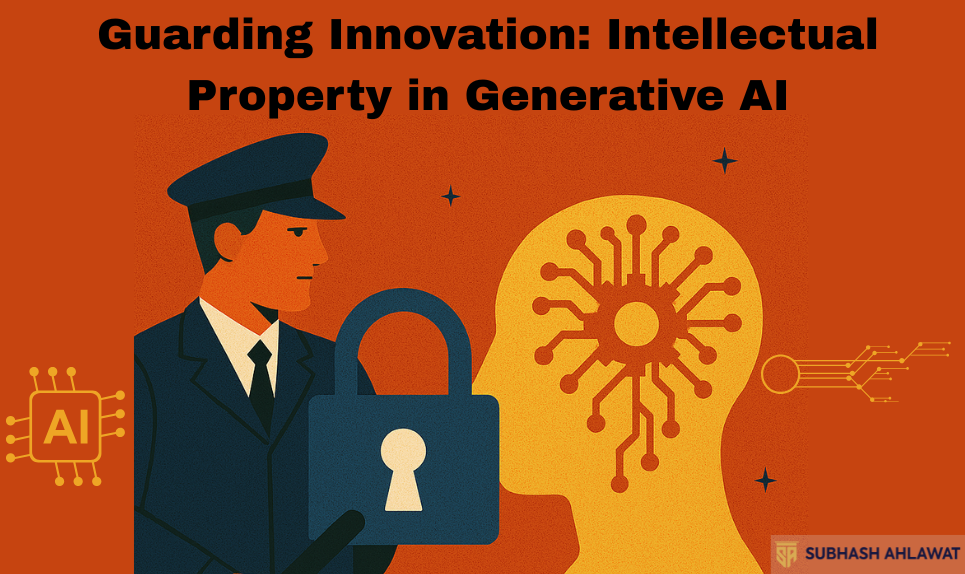Guarding Innovation: Intellectual Property in Generative AI

Generative AI is a type of technology that creates new things. It can write stories, create images, or make music. These tools use patterns from data to form fresh ideas and content. As these tools become more common, people are asking questions about ownership and safety. They want to protect new ideas and keep them safe from misuse. This is where intellectual property (IP) laws come in. IP laws help inventors, artists, and business owners protect their ideas. But when technology is so new and complex, there can be challenges. In this piece, we will look at how IP laws guard innovation in the world of Generative AI.
What Is Intellectual Property?
Intellectual property (IP) refers to the legal rights given to creators of original works. These works can include art, music, books, inventions, and brand names. IP rights encourage people to come up with new ideas. They allow creators to profit from their work and stop others from copying it without permission. There are four main kinds of IP:
Patents: These protect inventions, like machines or new processes. The owner has the right to stop others from making or selling the invention.
Copyrights: These protect creative works, like books, songs, and movies. The owner decides who can copy or share the work.
Trademarks: These protect brand names, logos, and symbols. They help people tell one product or service from another.
Trade Secrets: These are formulas, methods, or information that businesses keep secret. They can include recipes or designs. Sharing them can harm a company’s success.
With Generative AI, all these forms of IP can come into play. For instance, an AI system might write a new book or design a unique product. The result might be protected by copyright or patent laws. But there are still questions about who truly owns the output. Is it the person who built the AI, the person who trained it, or the tool itself?
Generative AI and Copyright
Copyright is very important in the area of Generative AI. AI models learn by studying large sets of data. This data can include books, images, or songs that are under copyright. AI developers must ensure that they have the right to use this data. If they do not, they might breach copyright laws. This could lead to legal problems.
In Generative AI, one big question is: who owns the content created by an AI model? Right now, most legal systems say AI tools cannot own copyright. That is because only a human (or group of humans) can hold copyright. Some laws say the owner of the AI model might have rights if they put in enough human effort in the creation. But this area is still developing.
There is also the concept of “fair use” or “fair dealing.” It lets people use parts of another work under certain conditions. For example, a researcher might copy a few lines of a book to write a report. But can an AI scan a whole library of books under fair use? This is still a gray area. Many courts are looking at how fair use applies to large AI training sets.
Generative AI and Patents
Patents protect inventions. They grant exclusive rights for a period of time. For an AI-based invention, a person or company can file a patent. However, Generative AI raises some new questions. For example, what if an AI comes up with a new design? Who can claim to be the inventor? Patent laws in many countries say an inventor must be a real person. This makes AI-based inventions tricky.
Some experts believe that the human who uses the AI is the inventor. They argue that a person directed the AI to create the design or product. Others say the AI is the real creator. In some cases, patent offices have rejected patents that listed an AI as the inventor. They say only a person can be an inventor. This debate may lead to changes in patent laws. After all, as AI becomes more powerful, it might create valuable inventions without a lot of human help.
Trademarks and Brand Protection
Trademarks protect brand names, logos, and symbols. They help customers know they are buying a certain product. In Generative AI, trademarks can come into play when an AI creates a new logo or brand design. If a company uses an AI tool to make a unique logo, they will want to register it as a trademark. That way, they can stop others from using it.
However, what if an AI tool creates something that looks like an existing brand? Could it confuse people? Could it break trademark rules? Yes, it could. If an AI-generated logo or name is too close to a known brand, it may lead to legal trouble. Companies that build AI models should train them carefully to avoid copying or imitating known marks. They might use filters or checks to make sure the output is not too similar to real brands.
Trade Secrets in AI Systems
Trade secrets protect information that gives a business an edge. This might be a special formula or a customer list. For AI, trade secrets can protect the code that runs the AI or the data used to train it. If the data set is unique, it can be treated like a secret. If a rival company got access to that data, it could damage the original company’s success.
Guarding AI trade secrets can be difficult. AI systems are complex, and many people might work on them. Sharing too much information can lead to leaks. On the other hand, not sharing enough might hurt progress. Companies must choose who can see the code and data. They might use contracts to ensure employees do not reveal secrets. They might also use encryption or other security methods. All of these steps help protect their trade secrets.
Legal Challenges in Generative AI
Generative AI does not fit neatly into old laws. Courts and lawmakers are still catching up. When an AI creates something new, it is not always clear if existing rules cover it. Some key legal challenges include:
Ownership: Who owns the output of the AI? The user? The developer? Or no one at all?
Infringement: Could the AI output break someone else’s copyright, patent, or trademark? If so, who is at fault?
Data Use: Are the datasets used to train the AI legal? Did the developers get permission to use copyrighted text or images?
Responsibility: If an AI causes harm, who is responsible? Is it the maker of the AI, the user, or someone else?
These questions have led to many court cases around the world. Governments and companies are watching closely. They want clear rules so they can invest in AI without worry.
The Role of Regulations
Governments around the world are making new laws or updating old ones to address AI. They want to encourage innovation but also protect people’s rights. Some rules focus on privacy, making sure data is used fairly. Others look at safety, ensuring AI does not harm people. IP rules are also being reviewed. Lawmakers must decide how to treat AI-made creations. Should they be protected under copyright? How should inventors be named on a patent? Different countries may have different answers. This could lead to confusion for global businesses.
In many places, law experts suggest that human effort should still play a big role. That is, an AI
creation should only have IP protection if a person guided or improved it. But as AI grows smarter, there may be less human work needed. This puts pressure on the legal system. Future rules may need to redefine what “creation” and “inventorship” mean when a machine is involved.
Helping Innovation While Respecting Laws
Companies that use Generative AI want to innovate. They also want to avoid lawsuits. To do this, they should keep some key points in mind:
Proper Data Use: Make sure the training data is lawfully obtained. If it includes copyrighted works, check if you have the right to use them.
Clear Contracts: When working with AI developers or clients, define who owns the AI output. Spell out how IP rights will be shared.
Monitoring AI Output: Keep track of what the AI creates. Use tools that can spot similarities to existing works, logos, or patents.
Legal Advice: Talk to IP lawyers who know AI. They can help you understand local and global rules.
By following these steps, businesses can protect themselves from IP troubles. They can also show respect for other people’s rights.
Balancing Freedom and Protection
Innovation often needs freedom. Scientists and developers should be able to explore new ideas. But creators also need protection. This encourages them to spend time and money on research. IP laws are meant to provide this balance. Generative AI is a big leap in how we create art, music, and more. But it also tests our old systems. Courts and lawmakers must update rules to match new technology. At the same time, creators of AI should act responsibly. They should use fair data, credit sources, and respect existing rights.
The Road Ahead
Generative AI is changing how we think about creativity and invention. It can produce paintings, stories, or even new drug formulas. This is exciting, but it also raises tough questions about ownership. Governments, courts, and companies are still learning how best to handle these issues. Intellectual property laws will adapt over time. We might see new rules on AI authorship or more flexible laws around training data. These changes can help society get the most out of AI while respecting people’s rights.
The road ahead is both hopeful and uncertain. AI gives us amazing tools, but we must use them wisely. Laws about IP will play a big part in shaping the future of Generative AI. They will help define who owns AI creations and how we protect them. This will impact inventors, artists, and businesses around the world. As we move forward, it is important to work together—lawmakers, tech experts, and the public. By doing so, we can ensure that Generative AI remains a source of growth and creativity, without causing harm to human authors and owners of existing works.
In conclusion, Generative AI is a powerful force. It can help us do things we never thought possible. Yet, with great power comes a need for strong rules. Intellectual property laws must keep pace with these advancements. We need clear guidelines on AI ownership, careful use of copyrighted data, and better ways to protect trade secrets. At the same time, we must encourage new ideas and not block progress. It is a delicate balance. By guarding innovation with fair IP practices, we can let Generative AI flourish. We can also protect the rights of those who invent and create, ensuring a bright future for everyone involved.


